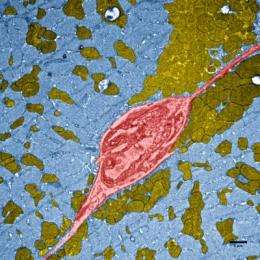Tweaking a gene makes muscles twice as strong

A team of researchers at EPFL, the University of Lausanne and the Salk Institute created super strong, marathon mice and nematodes by reducing the function of a natural inhibitor, suggesting treatments for age-related or genetically caused muscle degeneration are within reach.
It turns out that a tiny inhibitor may be responsible for how strong and powerful our muscles can be. This is the surprising conclusion reached by scientists in EPFL's Laboratory of Integrative Systems Physiology (LISP), in collaboration with a group in the Center for Integrative Genomics at the University of Lausanne and at the Salk Institute in California. By acting on a receptor (NCoR1), they were able to modulate the transcription of certain genes, creating a strain of mighty mice whose muscles were twice a strong as those of normal mice.
Two protein-building regulators
The process of transcription, in which proteins are manufactured by an organism in response to instructions contained in its DNA, is modulated by co-factors. These either favor (coactivators) or inhibit (corepressors) transcription, in principle by responding to the concentration of certain hormones in the body, which are in turn associated with the organism's environment.
In an article appearing today in the journal Cell, a team led by EPFL professor Johan Auwerx reports on the results of experiments done in parallel on mice and nematodes. By genetically manipulating the offspring of these species, the researchers were able to suppress the NCoR1 corepressor, which normally acts to inhibit the buildup of muscle tissues.
Better muscles
In the absence of the inhibitor, the muscle tissue developed much more effectively. The mice with the mutation became true marathoners, capable of running faster and longer before showing any signs of fatigue. In fact, they were able to cover almost twice the distance run by mice that hadn't received the treatment. They also exhibited better cold tolerance.
Unlike previous experiments with so-called super mice, this study addresses the way energy is burned in the muscle and the way the muscle is built. Examination under a microscope confirmed that the muscle fibers of the modified mice are denser, the muscles are more massive, and the cells in the tissue contain higher numbers of mitochondria--cellular organelles that deliver energy to the muscles.
Similar results were also observed in nematode worms, allowing the scientists to conclude that their results could be applicable to a large range of living creatures.
Obese but not diabetic
According to a second article published in the same journal and also involving EPFL's LISP Laboratory, suppressing the NCoR1 receptor in adipose tissues (fat) also led to interesting results. By acting on this corepressor, it was possible to fundamentally change the corpulence of the mice being studied without inducing weight-related diseases. "The specimens that became obese via this treatment did not suffer from diabetes, unlike mice who become obese for other reasons," notes Auwerx.
The scientists have not yet detected any deleterious side effects associated with eliminating the NCoR1 receptor from muscle and fat tissues, and although the experiments involved genetic manipulations, the researchers are already investigating potential drug molecules that could be used to reduce the receptor's effectiveness.
Treating degeneration
The researchers say their results are a milestone in our understanding of certain fundamental mechanisms of living organisms, in particular the little-studied role of corepressors. In addition, they give a glimpse at possible long-term therapeutic applications. "This could be used to combat muscle weakness in the elderly, which leads to falls and contributes to hospitalizations," emphasizes Auwerx. "In addition, we think that this could be used as a basis for developing a treatment for genetic muscular dystrophy."
If these results are confirmed in humans, there's no question it will attract interest from athletes as well as medical experts. "It will be important for anti-doping authorities to monitor that these treatments are not used in an unauthorized manner," concludes Auwerx.
















